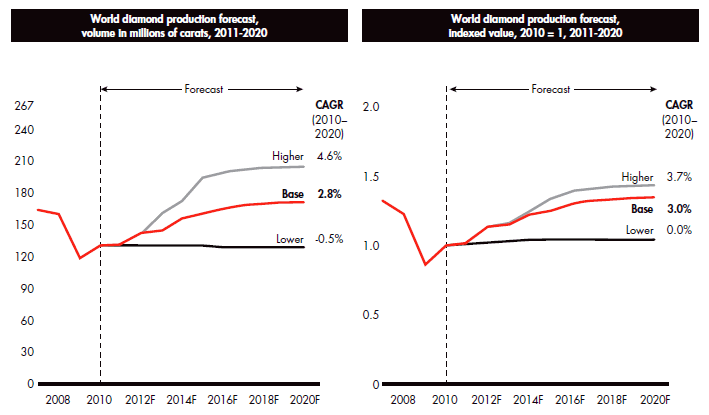Double Dip or Not – The (Long-Term) Future is Bright
December 15, 11
The number of middle-class households in
The report paints mainly an optimistic portrait. For instance, the jewelry market is predicted to grow to $147 billion this year from $139 billion in 2010, a handsome 5.8 percent growth.
One rather hidden insight is that the diamond industry is a “normal” industry. This is mostly true on the mining side of the business, but also on the retail end. Consumers worldwide spend about $227 billion a year on luxury goods. Of this, about $160 billion is estimated to be spent on fine jewelry – set with diamonds or other gems.
Despite the 2008 crisis, jewelry's market share was maintained. "No firm evidence attests that other luxury goods or electronics are being substituted for diamond jewelry," the report states.
In fact, this market share has been so steady in the recent past, that despite a sharp growth in generic advertising by De Beers, diamond sales did not grow by very much towards the of the end of the 20th century. This explains why the A Diamond is Forever campaign was killed.
The report also expects De Beers and Alrosa, dubbed “single-product focused majors,” to remain the dominant diamond mining forces. However, at the global diversified natural resource conglomerates BHP Billiton and Rio Tinto, diamonds revenue contribution will continue to shrink.
Global rough-diamond supply forecast 2011-2020  Source: Bain analysis |
Bain also breaks the myth that diamonds and the diamond business are unlike anything other, finding similarities to iron ore and coal – all are non-homogenous products, the business models of key players are similar, as are the tight relationships between producers and buyers.
The similarities end at a key point, needed for any industry to grow and, as repeatedly called for in this column – pricing transparency. While jewelry and industry are the main consumers of diamonds, the investment community is not a meaningful player. "(T)he lack of liquidity make [diamonds] largely unsuitable as a financial investment at this time," Bain explains. How true – and unfortunate.
To date, none of the attempts to create investment demand for diamonds have succeeded and that is a shame. The growth opportunities this could provide the industry remains untapped at this stage.
This can change, especially as the financial markets could use diamonds as a hedge against volatile, fluctuating commodities.
While we wait for that to happen, we can take solace in the understanding that the expanding middle class in China and India, together with the resurgence in consumer consumption, should generate robust demand for the rest of the decade, even if a double dip recession takes place.
Have a peaceful and productive weekend.